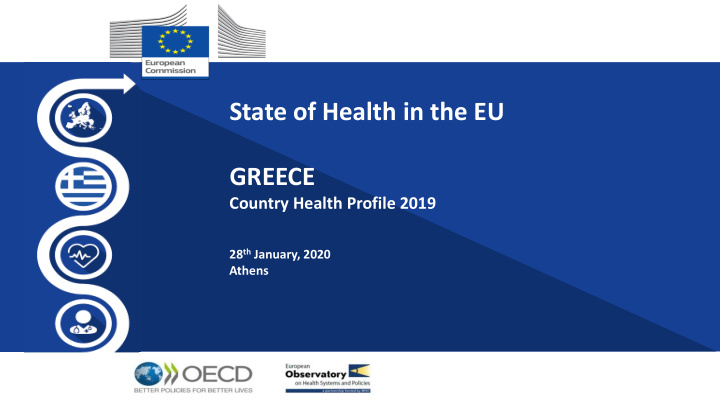



State of Health in the EU GREECE Country Health Profile 2019 28 th January, 2020 Athens
Overview “The State of Health in the EU’s Country Health Profiles are designed to be a one- stop-shop for knowledge and information on a country’s health system, put into the perspective of a cross- EU comparison.”
HEALTH AND RISK FACTORS
Life expectancy (LE) LE in Greece is still above the EU average, but increasing slower than in many other EU countries • LE at birth in Greece reached 81.4 years in 2017 • There is 5.1 years gap between women and men • At age 30, gap in LE by between highest and lowest educational attainment is 6 years for men and 2.4 years for women (for EU it is 7.6 and 4.1 respectively).
Mortality • Stroke and ischaemic heart disease are by far the leading causes of death • Mortality from the leading causes of death is falling, but mortality from diabetes and some cancers is growing • The infant mortality rate has reversed in Greece in recent years
Risk factors • Smoking has decreased since 2000, but 27% of adults (2 nd highest rate in the EU) still smoke daily (34% of men and 21% of women) 24% of children are overweight or obese (2 nd highest in the • EU), and 17% of adults are obese • Binge drinking rates are among the lowest in EU countries
THE HEALTH SYSTEM
Health financing Health spending per capita in Greece decreased rapidly during the economic crisis and now is around 45 % less than the EU average • In 2017, spending on health care was EUR 1,623 per person (EU average EUR 2,884) or 8 % of GDP (EU average 9.8 %); • Spending by function: 42% - inpatient care 31% - pharmaceuticals 2% long-term care 22% - outpatient care 1% - prevention • 35% of total spending comes from households (4 th highest in the EU)
Human and physical resources • Imbalance in distribution of health workforce, both geographically and in skill-mix • Facilities are disproportionately located in urban areas • Lack of planning mechanisms
PERFORMANCE OF THE HEALTH SYSTEM
Effectiveness • Cardio-vascular diseases are responsible for a large proportion of avoidable deaths shortcomings in diagnosing and treating patients at high risk of CVDs and in managing patients with IHD. • 30% of deaths from preventable causes are due to lung cancer historic and current tobacco control policies. • 25% of deaths from treatable causes are due to treatable cancers (breast, colorectal and cervical) weaknesses in cancer screening programmes and socio- economic inequalities in screening. • Generally high rate of vaccination coverage, but some gaps lead to outbreaks. • Lack of comparable data on many health care quality and effectiveness indicators.
Accessibility Level of OOPs is double the EU average (35% vs 16%) 2 nd highest level of unmet medical need (10%), and the Pharmaceuticals and inpatient care are the largest causes of OOPs largest income inequality gap in the EU 10% of households experience catastrophic spending, mainly affecting the poorest households Cost is the main barrier preventing access to services Level of unmet need reduced since comprehensive 25% of OOPs are informal, and pose major risk to access, financial protection and equity coverage was reinstated in 2016
Resilience • Pre-crisis issues, such as fragmentation, severe inefficiencies and supply-induced demand have partially been addressed, but post- crisis growth in spending is slow and continues to be shaped by fiscal constraints. • Cost ceilings, clawbacks and rebates mean less is spent by the state on medicines and services, adding estimated 1% of GDP to public spending. • Emigration and freeze on recruitment exacerbated imbalances and staff shortages, but there are now plans to hire 10,000 health professionals (subject to availability, training and adequate funding). • Primary care is being rolled out since 2017, now covering over 2 million people. Further expansion is subject to continuous investment. • Overarching high-level plan is needed to take stock of the changes, build on them effectively and guide the future reforms in line with health system performance and population needs.
ec.europa.eu/health/state oecd.org/health/health-systems/country-health-profiles-EU.htm euro.who.int/en/about-us/partners/observatory/publications/country-health-profiles
Recommend
More recommend